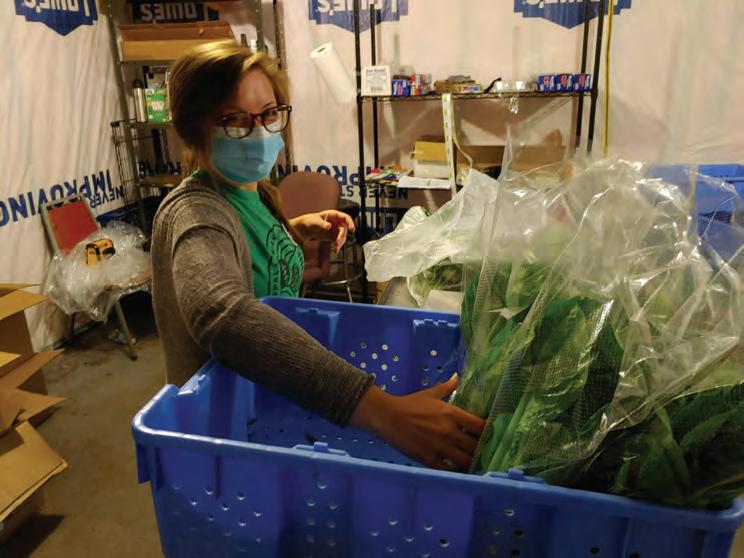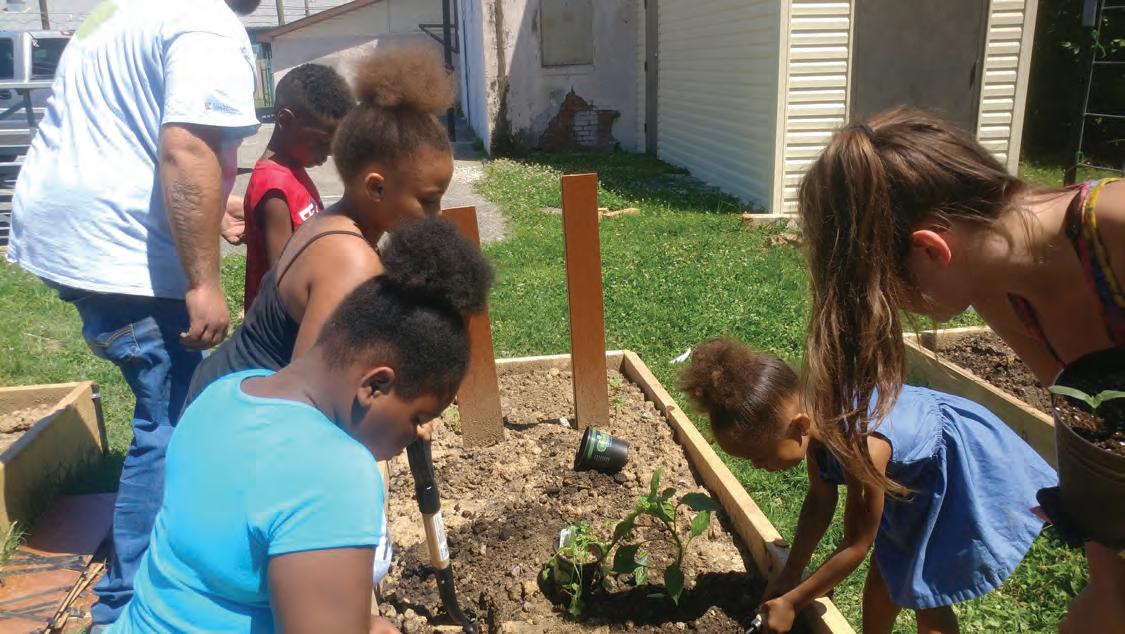
10 minute read
WEST VIRGINIA STRONG A resilient food system in the face of COVID-19 by Jessi Adcock
Resilient operations seek every avenue of conservation and restoration that is suitable for the land. Restoration of riparian areas increases forage production, increases water availability for herds, improves livestock condition, and reduces irrigation need by raising the water table. The NRCS and the U.S. Fish and Wildlife Service have numerous partnerships and opportunities available to ranchers and farmers that can help achieve these goals. Conservation easements are another common path of land stewardship which may be particularly helpful for struggling operations, since the producer receives payment upfront. And finally, let it not go unmentioned that if national and local policies were aligned with resilient agriculture, ranchers and farmers would be compensated for ecological goods and services that are not typically commodified (water retention, carbon sequestration, etc.). Perhaps most importantly for resilience, producers must join coalitions and support their communities. I have never seen an operation survive in isolation without engaging in environmentally destructive management practices. Aligning policies toward a resilient agroecological system requires ranchers and farmers to form and support politically active networks (such as the National Grazing Lands Coalition and the Rural Voices for Conservation Coalition). Consider for example how forming coalitions with neighboring producers and energy companies has allowed the Thunder Basin Grasslands Prairie Ecosystem Association to protect eight threatened species and control a variety of invasive species across 1.2 million acres, all while providing sustainable livelihoods for ranching families. Coalitions like the Quivira Coalition, Covenant Pathways, Northeast Farmers of Color, and many others across the globe have brilliantly incorporated social issues such as gender, race, socioeconomics, and access to land into the fabric of their programs. Their power lies in the collective breath of their communities. Because of the resilience of these coalitions, both producers and consumers involved have been able to remain strong throughout the pandemic, even if they have been knocked down by it.
Breathe and Rise Up!
Advertisement
During my first gasshuku, the thought of quitting entered my mind many times, especially when everything hurt and I fell to the ground from sheer exhaustion. I felt weak, I felt worthless, and I felt disconnected from those around me, whom I saw as stronger and more capable — my pain wasn’t just physical. “Even if you collapse, kiai, find strength in the kiai of your fellow karateka (community) and shomen (previous masters/ancestors),” my sensei counseled. Perhaps I was being pretentious in understanding my struggle and those of the members of my community. Judging ourselves and others based on a partial snapshot in time dehumanizes all involved because it ignores our personal and collective historical struggles and blinds us to the immense strength and wisdom we can gain from the struggles of our elders and ancestors, those who have walked these paths before. Without humbling myself and testing myself in the way of my elders and ancestors, I would fail to fulfill my natural role within the interdependent chain linking me to all living beings: my breath would never be in sync with theirs, and their collective strength and wisdom would be lost on me. Four days into the gasshuku, my body had settled in the strength of my breath and the harmonious life force of my fellow karateka, and the struggle became joyous rather than painful. This is wisdom! — and interdependent, community-based self-knowledge, gained through struggle, is the seat of wisdom, the harbinger of resilience. Do not judge me by my success, judge me by how many times I fell down and got back up again. — Nelson Mandela
West Virginia Strong A resilient food system in the face of COVID-19 Story and photos by Jessi Adcock
Coal. Opioids. Poor. Forgotten. The words that first come to mind when you think of West Virginia are rarely complimentary. For decades, our economy has been based on outside companies extracting our natural resources: timber, coal, and now, natural gas. The land is often left unusable without the benefit of expensive, equipment-intensive restoration. The money is good for a while, but as the resource dries up, so do the jobs. This vicious cycle has repeated itself for generations. But that’s not what I’m writing about. Today, something amazing is happening in these mountains. Quietly, diligently, certain individuals and organizations have been working to rebuild the Appalachian economy from the ground up. They’re retraining miners and other workers who’ve been laid off as coal companies shutter their operations. They’re working with folks coming out of recovery programs, providing education and employment when many others are hesitant to do so. And they’re offering living wages to do this work, making it possible to stay in the state and still have a good quality of life. Coalfield Development is one such organization. Coalfield was started in 2010 to address housing issues in Wayne, West Virginia. Since then, it has pioneered a holistic workforce development program and grown into a family of social enterprises that includes agriculture and artisan trades, real estate development, and construction. These social enterprises have created 190 new jobs, helped place 95 workforce development alumni in full-time careers, and brought $16 million in investments to the region. I work for the agriculture-focused enterprise of Coalfield, which is called Refresh Appalachia.
Appalachia has a rich history of farming. The people here have been growing and preserving food for generations; we’ve had to, as these mountains can be hard to traverse even today. Let me give an example for those who aren’t familiar with the region. A few weeks ago, I looked up the address of a new cattle operation that’s looking to hire. As the crow flies, they’re only 10 miles from my house. The fastest drivable route requires 45 minutes to get there, and you can only go that way if the creeks aren’t up from the rain. If the creeks are up, it’s an hour and ten minutes. And I live in the foothills. Co-ops, food hubs, and educational farms have existed across West Virginia for years, but the state’s rugged topography has made the formation of a centralized system of local food production, aggregation, and distribution particularly challenging. In 2018, a group of farmers, organizations, businesses, and nonprofits formalized this growing network to create the Turnrow: Appalachian Farm Collective, West Virginia’s first and only multi-stakeholder food hub. Refresh Appalachia, under the umbrella of Coalfield Development, is one of those partners. Turnrow operates as an aggregator and distributor to both wholesale and retail markets, collecting food from individual farmers and dispersing it throughout the state. Through their partner organizations, they provide technical assistance and
production planning to farmers, helping them access larger markets and increase income from their operations. Turnrow has been growing steadily since its inception, providing food to schools, institutions, and retail customers across southern West Virginia. And then COVID-19 hit. With new uncertainty suddenly facing our national food system, demand for local food skyrocketed overnight. The number of people buying from Turnrow’s online retail farmers’ market increased by 400% in the month of March alone, as existing customers began doubling their normal orders. Turnrow added new distribution locations and opened a mini market in Alderson, West Virginia, which has no grocery store. At the same time, many West Virginians were
School produce boxes.

laid off or furloughed due to the pandemic. Like elsewhere in the country, families were forced to choose between buying food and keeping the lights on. While middle-class folk spent additional money buying local, food banks started seeing ever-increasing demand as more families lost their meager savings. Feeding America estimates an additional 17.1 million people could become food insecure across the country as a result of the pandemic. Here in West Virginia, where one in six people already struggle with hunger, COVID-19 created an even greater strain on local sources of emergency food. Not only did the demand increase, but food banks, schools, and other organizations had to figure out how to get food to families with as little contact as possible, as quickly as possible. Annie Humes, Operations Manager and Farm to School Coordinator for the Turnrow Farm Collective, said that schools were given three days’ notice to shift their food preparation from the cafeteria to boxed meals that could be picked up or dropped off to students in their district. Overnight, the demand for frozen cubed squash and chopped salad mix — Turnrow’s main Farm to School
items — disappeared, replaced by the need for transportable foods that fit schools’ limited budgets. One school district in the southern coalfields needed 47,000 apples to supply their students and families for a week. After exploring options and connecting with partners through Cooperative Extension — a function of the land grant act that provides agricultural and consumer health information through West Virginia University — Annie was able to source 3,000 apples from a historic family orchard in the northern panhandle. Since then, Turnrow has brought over 200,000 pieces of fruit from the northern panhandle to Wyoming, Wayne, and Monroe counties in the southern coalfields, putting local fruit into the hands of students and expanding the market for that producer, while also strengthening the farm-to-school network.
Schools have been serving as channels for emergency food access for years. Before COVID-19, Turnrow had a good relationship with the Mountaineer Food Bank, one of two food banks in the state. Each week the food bank would order fresh local produce to help supply youth backpack programs in their service area. When the schools shut down, those programs closed too, but the students’ need for food remained pressing. Over the last six weeks, the food bank has purchased 600 prepackaged boxes of fresh produce and delivered them to Lewis, Barbour, and Upshur Counties, who then distributed them to families in need. This project is on hold now that the school year is over, but it is planned to resume in August. Beth Ryan is the Food Access Coordinator for Sprouting Farms, a founding member of the Turnrow collective. In the pre-COVID-19 days, part of Beth’s work involved planning for pop-up markets at childcare centers. Kids and their parents could shop together using vouchers provided by the organization KEYS 4 Healthy Kids. These markets offer the opportunity for kids and their parents to access and learn about fresh, local produce. The pandemic put the start date of these markets on hold, but they’re now about to launch in newly conceived fashion. Instead of being able to shop, kids will get to pick up a prepackaged box filled with fresh, local produce. At the same time, Beth and our other partners developed new relationships with hospitals, clinics, and doctor’s offices to get produce boxes to adults and families without children in daycare centers. AmeriCorps members at Turnrow’s other partner organizations have been working on food access projects across the southern part of the state as well. Elice Hunley, Refresh Appalachia’s AmeriCorps member, has been developing the Fairfield Community Garden in Huntington, one of West Virginia’s few urban centers. The initial plan for the garden was to reach production capacity and sell into the Turnrow Farm Collective, but as food insecurity among the community increased with COVID-19, the purpose of the garden shifted. Now, community members are growing food to feed themselves and their families, showing their kids that they can provide for themselves too, even in the city. This is just a snapshot of the work being done here in the mountains. I encourage all to check out the Coalfield Development Corporation, the Turnrow Appalachian Farm Collective, and the Central Appalachian Network, to offer support or learn more. While working on this piece, I asked friends on social media what came to mind when they thought of the state. The words at the beginning of this story may be accurate depictions of West Virginia, but they don’t paint the whole picture. To fill in the gaps, I’d add: Beautiful. Resourceful. Resilient.










